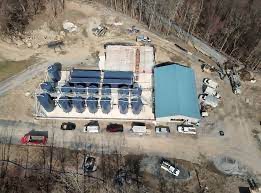From the Article by Jake Bolston, Inside Climate News, September 24, 2023
The Environmental Protection Agency has approved a permit for a toxic fracking wastewater disposal well named Sedat 4A in Plum, rejecting residents’ concerns that leaks from the well could migrate and pollute other wells and groundwater.
The decision comes as Pennsylvania faces a fracking disposal reckoning. Historically, the state has trucked much of its fracking waste to Ohio, which has a more robust infrastructure of injection wells. But now, as scrutiny over the safety of storing toxic wastewater underground mounts in Ohio, oil and gas companies operating in Pennsylvania find themselves in need of other reliable options for disposing of their wastewater.
In the fracking process, drillers pump up to 20 million gallons of water and fracking chemicals into a well at high pressure to extract gas from small seams in the Marcellus Shale. Once the well starts producing gas, about 5% to 10% of the water used to frack the well resurfaces.
Because this produced water has dissolved elements in the shale, it contains hydrocarbons, heavy metals and salt concentrations up to seven times higher than sea water, and can sometimes contain radium 226 or 228, radioactive isotopes, in addition to the chemicals added for fracking.
While almost half of Pennsylvania’s produced water is then recycled to frack additional wells, it reaches a point when it can no longer be reused and must be disposed of. Treating the water to remove the chemicals and natural contaminants is prohibitively expensive.
One solution has been to convert some of the state’s hundreds of thousands of conventional gas wells into disposal, or injection, wells. These conventional wells — which bore into porous rock formations and run only vertically a few thousand feet into the earth — were drilled decades ago, and many have been sitting abandoned for years.
In a day’s work, a typical injection well pumps millions of gallons of toxic wastewater from fracking thousands of feet below ground at high pressure into the old, abandoned well. Currently, there are 14 such injection wells operating in the state.
“We’re seeing a trend of these conventional well operators repurposing non-producing conventional wells into injection wells.” said Gillian Graber, executive director and founder of Protect PT, an organization focused on educating Pennsylvanians living in the state’s southwestern counties on the impacts of fossil fuel drilling on their communities. “These conventional wells are just simply not engineered for this purpose,” she said.
Injecting oil and gas waste down a well repurposed for disposal can test the limits of its materials.
“If you’re risking using an old well for many decades to come, it’s going to be repressurized many times at pressures higher than it ever saw as a gas well,” said Tony Ingraffea, a professor emeritus of engineering at Cornell University. Mr. Ingraffea, who has served as a consultant for residents fighting the proposed new well, added that repressurizations occur with each delivery, of which there can be several a day.
The new well would be the second in Plum. If proper steps are not taken to ensure the well maintains proper pressure levels, he said, the results can be dangerous. “The well should only be doing what it was designed to do, nothing more,” Mr. Ingraffea said.
Stephanie Catarino Wissman, executive director of the American Petroleum Institute’s Pennsylvania branch, said repurposed oil and gas wells are safe. “Industry standards and best practices, in tandem with stringent state and federal regulations, are designed to make energy development safe and responsible. Highly regulated by the state and U.S. Environmental Protection Agency, underground injection is the safest and most effective means of isolating waste while protecting groundwater and the environment,” she said in a statement.
The regulatory permitting process for Sedat 4A involved an EPA review of plans submitted by Penneco, an oil and gas waste disposal company, and a review of public comments made about the project. Commenters cited environmental, operational and geological concerns with Penneco’s proposals.
Based on data from the company, the EPA determined that the rock formation in Plum was suitable for holding large quantities of the toxic wastewater essentially in perpetuity, without leaking.
But the agency, in approving the permit last week, said Penneco could not begin operations at the disposal well without performing a test showing that there were no leaks, to the satisfaction of EPA’s Region 3 water division director.
Under federal law, the agency noted, an injection well has “mechanical integrity” if “there is no significant leak in the casing, tubing or packer;” and “there is no significant fluid movement into an underground source of drinking water through vertical channels adjacent to the injection well bore.”
Environmentalists and some Plum residents have strenuously opposed permitting a second well, citing environmental justice concerns, possible water pollution, increases in noise pollution, decreases in property values and potential harms to businesses as other reasons not to issue the permit. All of those concerns fell out of the agency’s “regulatory criteria,” which only concerns sources of drinking water in the area.
In the wake of the EPA’s decision, and pending approval from the DEP and other local governments, Sedat 4A would become the 15th injection well permitted in Pennsylvania and could go into operation this fall, barring further litigation that some Plum residents say they are exploring.
>>> This story is published by the Pittsburgh Post Gazette in partnership with Inside Climate News.

